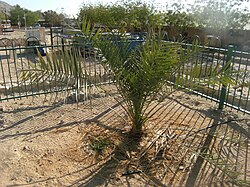Plants
Seed germination
York groundsel
The York groundsel is a species of Senecio that was first discovered in York, England in 1979 and last seen in the wild in 1991. [1] A survey by UK government advisory body Natural England found it was driven to extinction by 2000, partly due to the use of weedkiller. [2] Seeds of the plant were stored at the Millennium Seed Bank, successfully germinated, and reintroduced to York in 2023, marking the first time an extinct species has been revived and successfully reintroduced into its native range. [3]

Judean date palm
This section needs additional citations for verification .(August 2025) |
The Judean date palm is a cultivar of the date palm (Phoenix dactylifera) that is historically endemic to ancient Judea (modern-day Israel and Palestine). It is genetically unique, and closely related to modern Iraqi and Moroccan varieties. [4] [ better source needed ] Between 1963 and 1991, archaeologists discovered Judean date seeds in excavation sites. Through radiocarbon dating, they were determined to be between 1,900 and 2,300 years old. In 2008, researchers at the Arava Institute for Environmental Studies began to germinate the seeds. [4] [ better source needed ]
As of 2023 [update] , seven Judean date palms have successfully germinated. In 2020, researchers began to harvest dates from these trees. Experiments to revive this cultivar are ongoing. [5] [ better source needed ]
Montreal melon
The Montreal melon, also known as the Montreal market muskmelon, Montreal nutmeg melon, and melon de Montréal (Melon of/from Montreal) in French is a commercial cultivar of melon native to Canada. It was traditionally grown around the Montreal area, hence its namesake. The fruit was known for being the largest melon in North America during its initial cultivation. [6] It disappeared entirely from family farms and cultivation in the region by the 1920s due to industrialisation in Canada and being ill-suited for agribusiness. In 1997, seeds of the melon were discovered in a seed bank in the American state of Iowa. Since then, the Montreal melon has been reintroduced to its former range by local gardeners. [7]
Unknown Commiphora
In September 2024, a specimen of a never-before-seen Commiphora by the name of Sheba reached maturity. In the 1980s, Sheba was found in excavations of a cave in the Judean desert as seed but was not germinated until recent times. Sheba is estimated to be over 1000 years old through radiocarbon dating, and researchers suspect that Sheba may be the tsori or Judean balsam, two plants stated to have healing properties in the Bible. [8] [9]